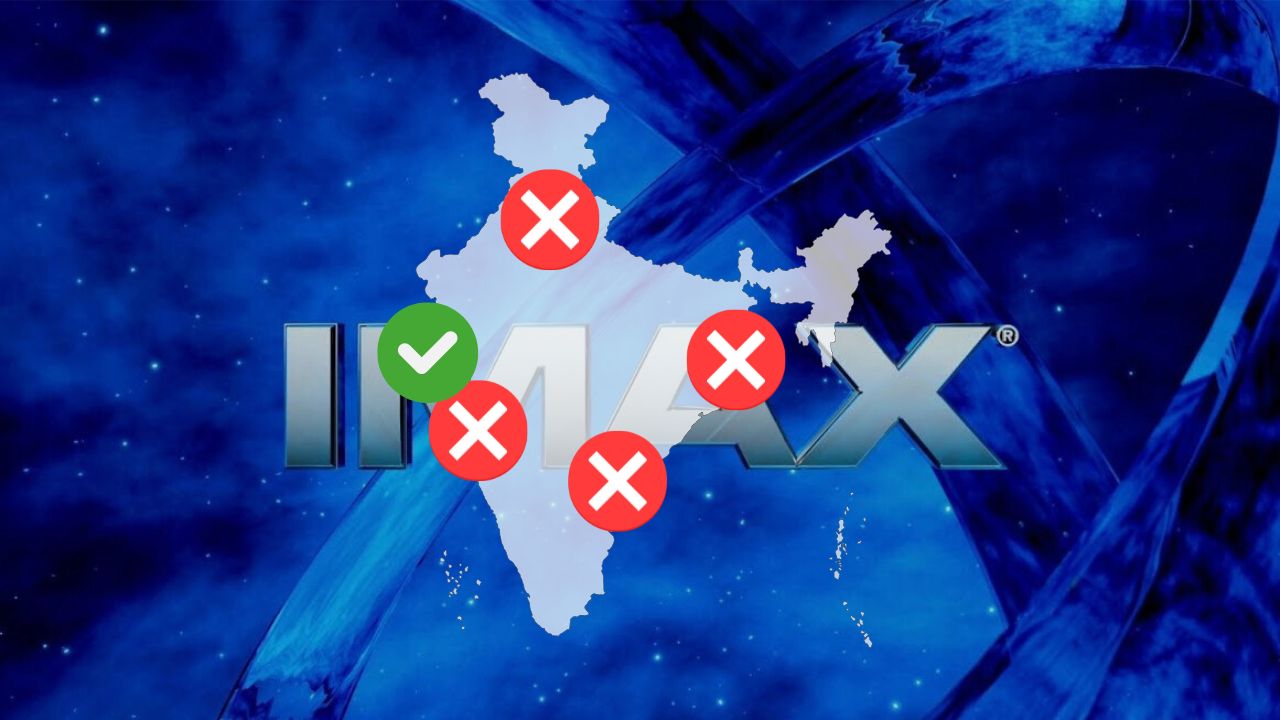Last updated on 6 October 2025.
IMAX is gaining popularity in India, but there is still one piece missing from the puzzle. For a country with a huge population that loves cinema, we don’t have a single ‘commercial’ 70mm IMAX theatre. Believe it or not, we actually used to have 5. So, what happened? Let’s rewind a bit.
Does India have a 70mm IMAX Theatre?
India has only one 70mm IMAX screen, installed at Gujarat Science City in Ahmedabad.
However, it doesn’t show any hollywood or Indian movies.
70mm IMAX was not just about the screen size; it’s what cinema should be. The massive film reels, thunderous sound, and that floor-to-celing image made you feel like you were inside the movie. It had a great beginning in our country!
India once had five 70mm IMAX theatres. Here’s where they were:
- IMAX Adlabs, Mumbai
- Gujarat Science City, Ahmedabad
- Prasads IMAX, Hyderabad
- Aeren R Multiplex, Ghaziabad
- Aeren R, Kolkata
Now, only one of them lives!
While India now has more than 30 IMAX screens showing the latest movies, sometimes even with laser-sharp quality, all of them are digital. So, what’s the difference? Why should 70mm matter? Let’s check that first.
Honestly, all these digital IMAX theatres are awesome. I love watching movies there. The screens are massive, with a taller 1.90:1 aspect ratio, bigger than a normal screen.
Whenever a “Filmed for IMAX” movie releases, there are some special IMAX-shot scenes, you only get to see the full picture in the IMAX theatre:
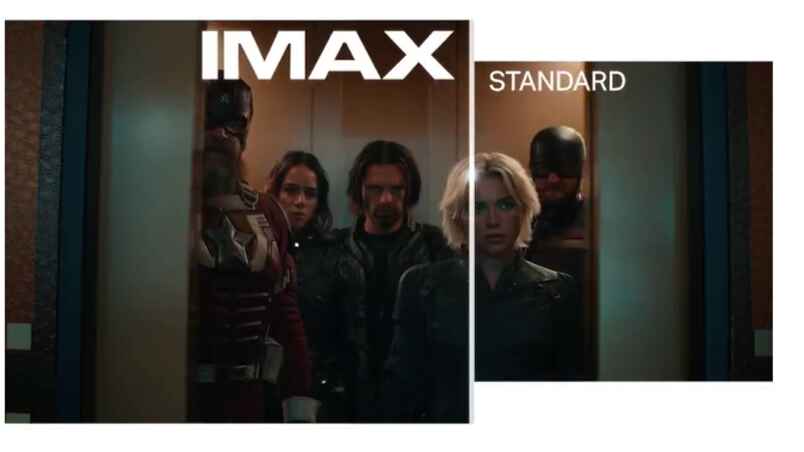
Some of them have 4K Laser projectors as well, which provide crystal-clear visuals. Combined with their 6-channel or 12-channel audio system, which will give you a truly immersive experience like nothing else.
But once in a while, there is a real IMAX film like Oppenheimer, made for 70mm IMAX. These have a bigger 1.43:1 aspect ratio, which means you see more of the frame than usual. Look at the difference here:
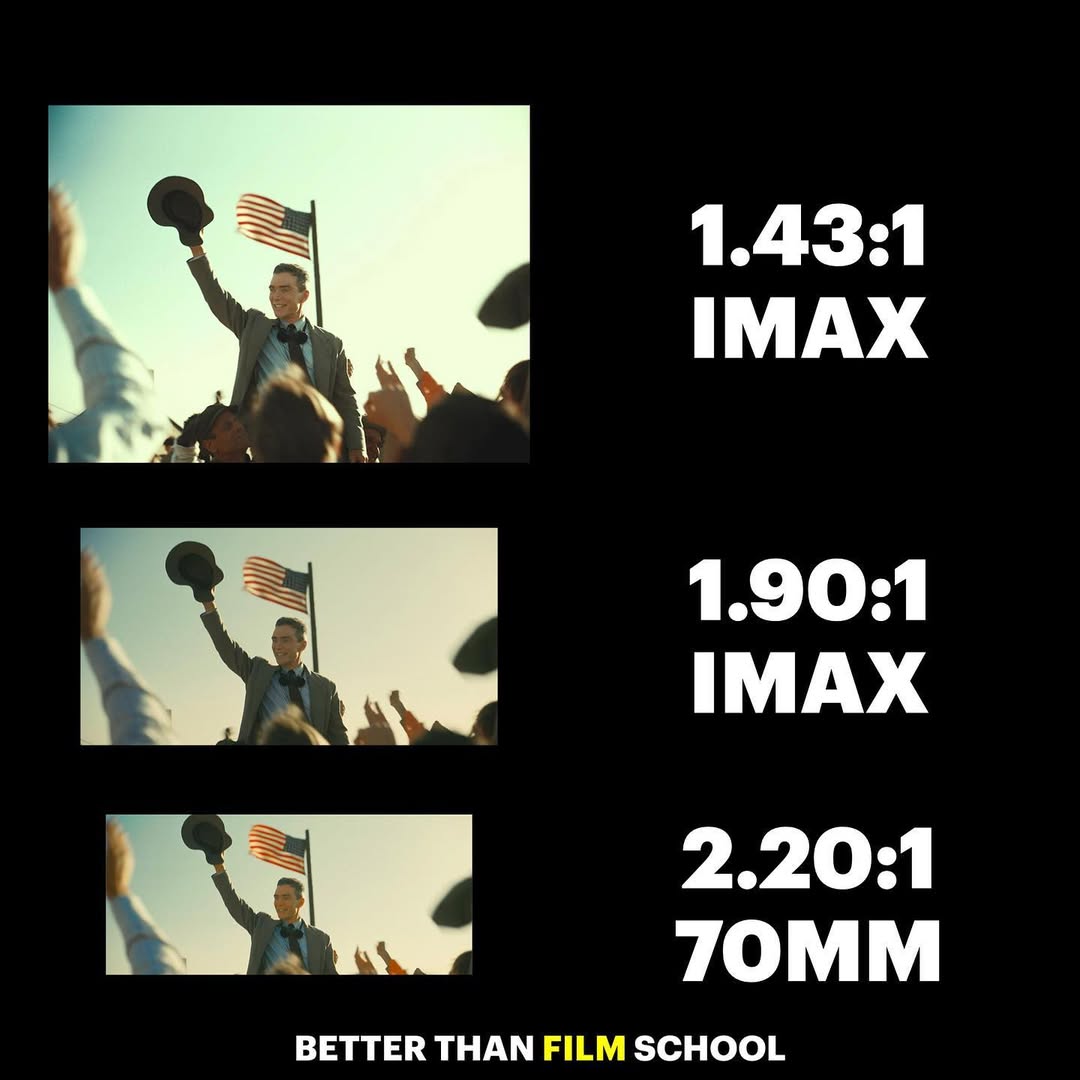
Such films are shot on a 15/70mm reel, with a resolution of up to 18K. This is the best clarity anybody can achieve. The 70mm prints had an unmatched level of detail, depth, and sharpness that digital cameras can’t replicate.
You could almost feel the texture of every frame.
Sadly, Indians can’t watch these 70mm IMAX films in their true potential. Let’s discuss one by one what happened to all the 70mm IMAXs in India.
1) IMAX Adlabs Wadala
Everything started here.
India got its first IMAX theatre in 2001, built by Adlabs at Wadala, Mumbai.
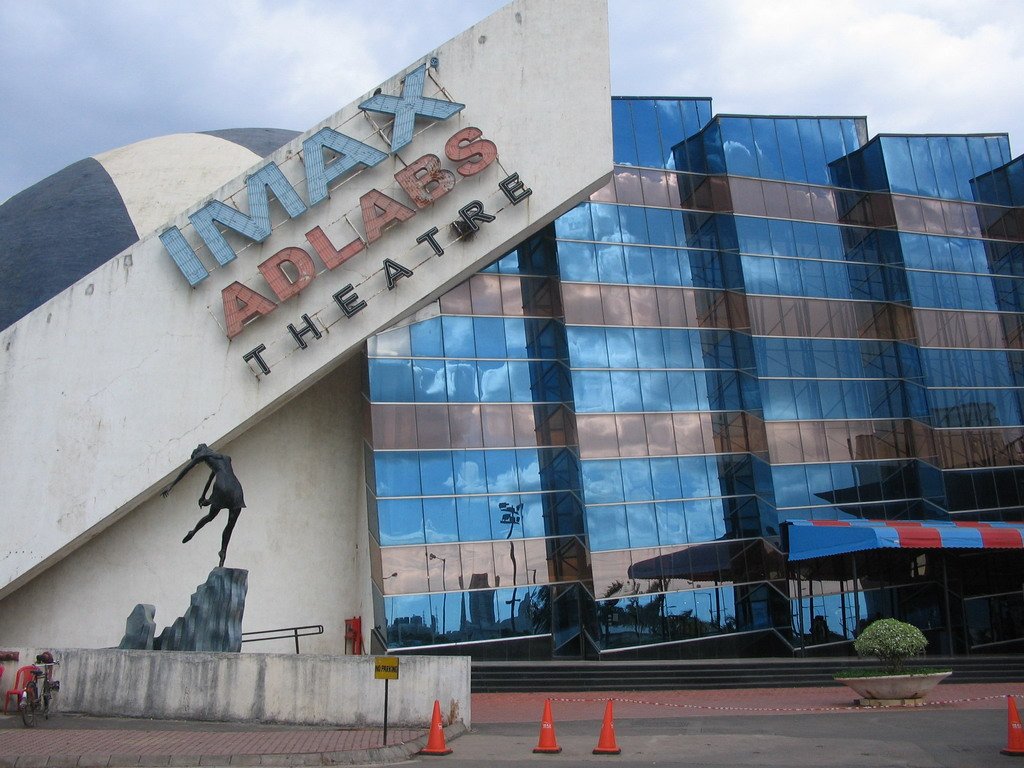
It was a Dome structure with a curved screen, and the largest at the time in the world.
Manmohan Shetty, the owner of Adlabs, wanted to make a huge splash in the movie exhibition business. So, he decided to bring this cutting-edge technology to India. He reportedly spent around ₹55 crores on the project.
This was way before Christopher Nolan shot The Dark Knight (2008) in IMAX, or even IMAX started releasing big Hollywood blockbusters by digitally remastering them, like Star Wars: Episode II – Attack of the Clones or Spider-Man 2.
In those early days, IMAX theatres mainly showed short documentaries on nature and space. These documentaries pulled in kids and families. The plan was to keep this IMAX as an attraction to bring more people to the Multiplex.
And for a while, it worked. The giant dome screen wowed audiences.
This place saw many Bollywood movie premieres as well.
But in 2005, Reliance’s Big Cinemas took over. They swapped the legendary 70mm film projector for a digital one in 2009. The downgrade made it India’s first digital IMAX theatre. But why did they do that?
Well, the documentaries can’t pull an audience for years.
The screen needed new content, like hollywood movies. But it was expensive as well as difficult to get physical prints for new movies on time. On the other side, digital versions were readily available. So, it made sense.
Then Carnival Cinemas acquired the place. They had a chance to make something out of this premium screen, but they didn’t. The place wasn’t kept in a good shape and became a lost icon. Carnival shut it down in 2023.
The only highlight during this period was a special screening of Dunkirk in true 70mm IMAX in 2018.

Chirstopher Nolan was in India that year to support the Film Heritage Foundation (FHF) and this screening was a one-time event for fans to experience his movie exactly the way he intended.
But hey, there’s a happy ending to the story!
In 2024, Miraj Cinemas gave the multiplex a new life, now equipped the huge IMAX screen with Digital 4k Laser projectors. It’s officially the biggest IMAX in India, with a 72-foot-wide screen.
They also still kept the old 70mm projector as a piece of cinema history.
2) Gujarat Science City IMAX
Gujarat Science City opened in 2002 with India’s first 70mm IMAX 3D theatre. The screens stretched 96 feet wide and 67 feet tall, with a 1.43:1 aspect ratio.
Since it was part of a government facility, the focus wasn’t really on commercial movies. Still, they treated audiences to some Hollywood hits like Titanic, Avatar, and more in 3D. But they stopped after that.
Noww you would only get only those space and nature documentaries.
Shrey Tyagi has made a good video explaining the technical marvels of this theatre from the projection booth in this video:
The reason it stopped screening the hollywood movies was the cost. Importing IMAX film prints was incredibly expensive, and for a government-run centre, where everything requires approvals and permissions, it was not something they could afford.
Jitendra B Vadar, Executive Director of the Gujarat Council of Science City, told Gujarat Samachar in 2024 that they couldn’t get Interstellar and Avatar: The Way of Water prints because “IMAX even charges a fee to check availability” of them.
Someone asked about this only 70mm screen to the IMAX VP of the India region, and this was his answer:

Digital looks like the best hope! Maybe that will happen soon, and we will lose our last 70mm screen.
The management is also planning to get a digitial projector. It might still retain the 1.43 ratio if they go for a GT Laser projector. But no exact date is fixed for this renovation.
That doesn’t mean it will become a movie hub. The aim is still to keep the auditorium for educational content only.
3) Prasads IMAX
While the first two were designed for documentaries, Prasads was solely built for cinema.
Prasads IMAX opened in 2003, boasting the largest IMAX 3D screen in the world at the time. The screen was 95 feet wide and 72 feet tall.
LV Prasad Group was a leading player in the film industry, who wanted to do something big for the nation and the state that loves watching movies.
Here’s what Ramesh Prasad said about bringing this tech to India:
“In the early 90’s I made a visit to the Smithsonian Museum in the US and was exposed to an IMAX presentation. Showcasing the film, To Fly, truly got me by surprise. Post which I had made up my mind to bring this experience to India.
Hence, visited the Toronto office. Keeping a keen eye and minds determined, we completed the project in a matter of 17 months. Cinema was the prime focus for us, we didn’t look for anything else. Being the first to get IMAX introduced, many more records broke in terms of attendance alone.“
Just like Wadala, the idea was the same here. Keep the IMAX (Screen 6) as a key attraction. It was just showing those documentaries until big Hollywood films started getting digitally reamastered by IMAX, like Spider-Man 2, Man of Steel, Iron Man 3, The Amazing Spider-Man etc.

About 1,30,00 people watched Spider-Man 2 at Prasads and Adlabs, contributing 8% of the total box-office from India from just 2 screens.
Major blockbusters like The Dark Knight, The Dark Knight Rises, Mission Impossible: Ghost Protocol, and Interstellar were released here in full 1.43 expanded aspect ratio with the superb clarity of 70mm projectors.
Prasads was the only place where you could have watched Interstellar in its full 70mm glory. In just 1 month, 75,000 people watched the movie on this giant screen. Note that the theatre capacity is around 600. We can easily guess almost every show was housefull.
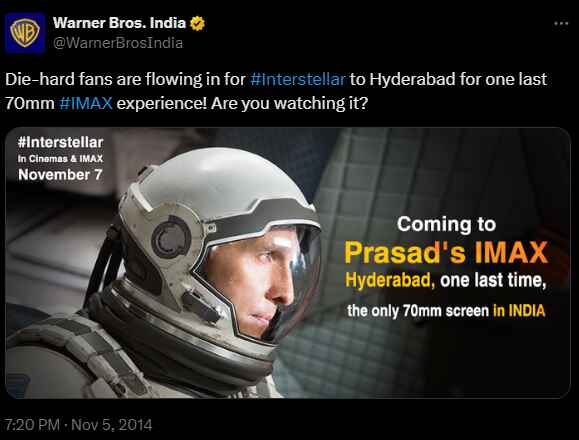
It remained the last hope for commercial 15/70mm IMAX in India after Wadala’s projector got converted to digital, and Gujarat Science City stopped screening commercial films.
“We have people from cities like Mumbai, Delhi, Chennai and Kochi visiting Hyderabad just to watch the film in the IMAX format.”
–T. Srikanth, General Manager, Prasads
We can only imagine how majestic Prasads IMAX must have been, because its journey ended in 2014. The cost had gotten too high and the logistics too tricky. Like I mentioned earlier, importing physical prints was expensive.
On top of that, state government rules capped ticket prices. They couldn’t run such a big theatre without charging a higher price to the audience. Screen 6 was slowly turning into a financial burden.
Even if they decided to get the prints, they couldn’t get them on time. Everything was moving to digital, and not many distributors were released in physical prints. When Dhoom 3, the first Indian movie in IMAX, came out, it was also missing the print format. So, Prasads couldn’t show it.
Kaustubh Debnath, aka KDCloudy, has explained the whole situation in this great video, which you must check out:
In the end, the only way to keep the place running was to switch to something else. The 70mm IMAX projector was last used only for Interstellar. For cinephiles, losing it was heartbreaking!
But Screen 6 is still alive and kicking with the same massive screen size. You can spot it on ticketing sites with a PCX tag. Sure, you might miss out on the expanded aspect ratio scenes, but it is still the biggest screen you will find in India.
4) Aeren R IMAX in Delhi-NCR
While most people talk about the above 3, there are 2 more 70mm IMAX theatres in India that most people don’t even know about.
The first one popped up at Pacific Mall in Kaushambi, Ghaziabad in 2005. The company behind it was Aeren R, a real eastate company that wanted to get this new theatre tech to north and the south.
Here is the only photo of it you can find on the internet:
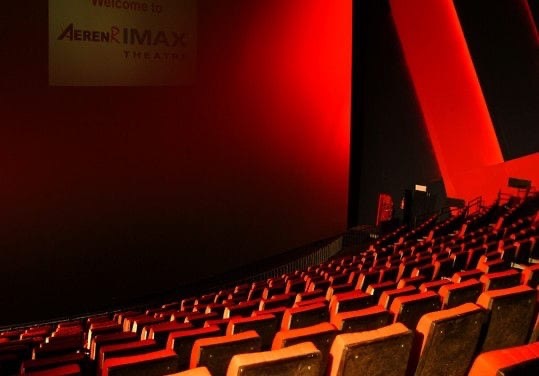
It had those same documentaries most of the time. So, the novelty of them wore off in a few months.
One of the other hurdles was the location. Being about an hour’s drive away from Delhi meant it never became a go-to destination. Combine it with the same content challenges discussed earlier of getting physical prints.
The release of Superman Returns 3D in 2006 was a rare exception, when they saw a significant boost in attendance.
Ultimately, the multiplex got sold to MovieMax, who still has the huge screen, listed as MAXX screen on ticketing websites.
5) Kolkata’s Aeren R’s IMAX
The second Aeren R IMAX was installed in Kolkata, inside the Mani Square Mall. It also had a life span of two years: opened in 2008, closed in 2010. The reasons are the same: high operating costs, and the a delay in physical prints.
“A blockbuster like Avatar was screened at IMAX at least 10 to 12 weeks after it had been released all over the world.”
Mahendra Soni, Shree Venkatesh Films (via Telegraph India)
The screen later became part of PVR, and they turned the screen into a PXL screen.
Aeren R also held licenses for Jaipur and Ludhiana, but that never came to fruition.
Will we have one in the future?
Not a good chance! Filmmakers, studios, and distributors are moving away from the 70mm format. When IMAX launched its “Filmed for IMAX” program in early 2020, they also made it clear that the focus is on digital.
The shift from 70mm to Digital is also about practicality. For cinema chains, Digital is cheaper to make, draws the same amount of audience, and they can show wide variety of movies there.
And if we look at the financial statements of India’s biggest cinema chains, they can’t bet something this risky. It would be such a large amount to invest for them.
The most I can imagine is that someday we might get a Digital GT Laser IMAX with a 1.43:1 aspect ratio. But if and when that will happen remains unknown. No company has any plans for it.
However, I am strange solution.
My best idea is that PVR-INOX could make use of the existing 70mm IMAX projector at Gujarat Science City.
They could rent the place for 2 to 3 months whenever the next 70mm release happens, like The Odyssey in 2026. The company can handle all the operations from importing the 70mm prints to selling tickets. It could become an event for all cinephiles of India. I will gladly pay for it!
Overall, India needs its own 70mm IMAX. It offers a cinematic expeirence unlike any other. A perfect blend of immersive scale and superior clarity. For country with a thriving film culture like us, it is a big gap in the market!
Takeaways
Now you know about all the 70mm IMAX theatres that once existed in India. A lot of desi cinephiles ask for this format regularly on social media platforms, but there is a very slim chance we can get one in the near future.
And if you don’t know who I am? I am Ranish Chauhan a.k.a. Fulmino Fan, and I love Marvel & DC Superheroes and Sci-Fi movies. You can also check my YouTube channel.
